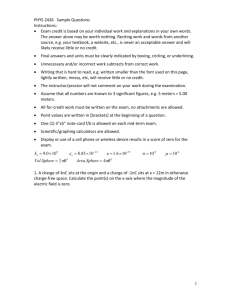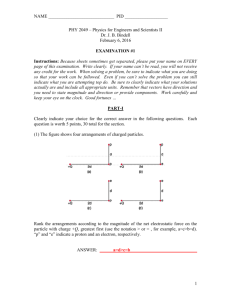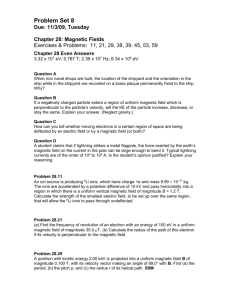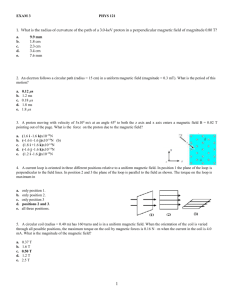Electromagnetism AP Multiple Choice Answers 2011
advertisement
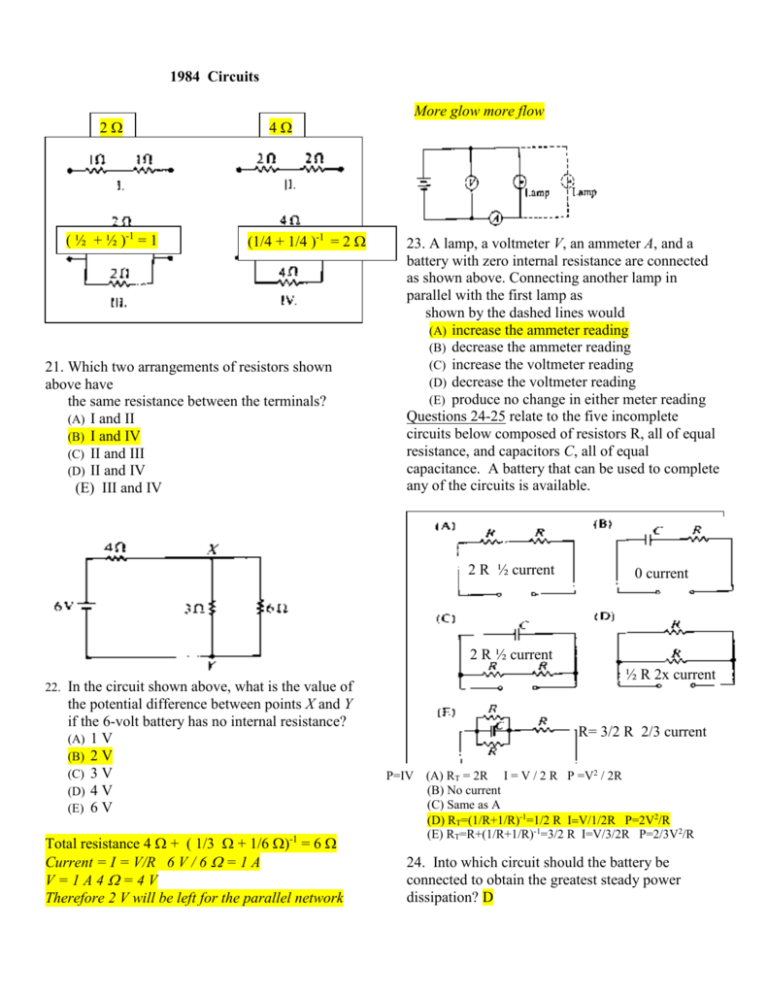
1984 Circuits 2 ( ½ + ½ )-1 = 1 4 (1/4 + 1/4 )-1 = 2 21. Which two arrangements of resistors shown above have the same resistance between the terminals? (A) I and II (B) I and IV (C) II and III (D) II and IV (E) III and IV More glow more flow 23. A lamp, a voltmeter V, an ammeter A, and a battery with zero internal resistance are connected as shown above. Connecting another lamp in parallel with the first lamp as shown by the dashed lines would (A) increase the ammeter reading (B) decrease the ammeter reading (C) increase the voltmeter reading (D) decrease the voltmeter reading (E) produce no change in either meter reading Questions 24-25 relate to the five incomplete circuits below composed of resistors R, all of equal resistance, and capacitors C, all of equal capacitance. A battery that can be used to complete any of the circuits is available. 2 R ½ current 0 current 2 R ½ current 22. In the circuit shown above, what is the value of the potential difference between points X and Y if the 6-volt battery has no internal resistance? (A) 1 V (B) 2 V (C) 3 V (D) 4 V (E) 6 V Total resistance 4 + ( 1/3 + 1/6 )-1 = 6 Current = I = V/R 6 V / 6 = 1 A V=1A4=4V Therefore 2 V will be left for the parallel network ½ R 2x current R= 3/2 R 2/3 current P=IV (A) RT = 2R I = V / 2 RP =V2 / 2R (B) No current (C) Same as A (D) RT=(1/R+1/R)-1=1/2 RV/1/2R P=2V2/R (E) RT=R+(1/R+1/R)-1=3/2 R I=V/3/2R P=2/3V2/R 24. Into which circuit should the battery be connected to obtain the greatest steady power dissipation? D 25. Which circuit will retain stored energy if the battery is connected to it and then disconnected? B because the capacitor can not discharge 26. A parallel-plate capacitor is charged by connection to a battery. If the battery is disconnected and the separation between the plates is increased, what will happen to the charge on the capacitor and the voltage across it? (A) Both remain fixed. (B) Both increase. (C) Both decrease. (D) The charge increases and the voltage decreases. (E) The charge remains fixed and the voltage increases. Since Capacitance is inversely related to distance between the plates then capacitance decreases. Capacitance is the ratio of the stored charge to the voltage. A decrease in capacitance will result in an increase in voltage C = eoA C=Q d V The charge remains fixed, the capacitor has not been dischared. 27. The five resistors shown below have the lengths and cross-sectional areas indicated and are made of material with the same resistively. Which has the greatest resistance? R = l the length is longer A the area is the least 28. Two capacitors are connected in parallel as shown above. A voltage V is applied to the pair. What is the ratio of charge stored on C2 to the charge stored on C1, when C1 = 1.5C2 ? (A) (B) (C) (D) (E) 4 9 2 3 1 3 C=Q V The capacitance of C1 is greater than C2 therefore The charge on C2 is less than the charge on C1 2 9 4 1988 29. The capacitance of a parallel-plate capacitor can be increased by increasing which of the following? (A) The distance between the plates (B) The charge on each plate (C) The area of the plates C = eoA d (D) The potential difference across the plates (E) None of the above 30. The total equivalent resistance between points X and Y in the circuit shown above is (A) 3 (B) 4 (C) 5 (D) 6 (E) 7 R= 2 + ( 1/2 + 1/2)-1 = 3 31. An electron volt is a measure of (A) energy 1eV = 1.6 x10-19 C ( 1 J ) = 1.6x10-19J (B) electric field C (C) electric potential due to one electron (D) force per unit electron charge (E) electric charge 32. The five resistors shown below have the lengths and cross-sectional areas indicated and are made of material with the same resistivity. Which resistor has the least resistance? 1993 34. Which of the following will cause the electrical resistance of certain materials known as superconductors to suddenly decrease to essentially zero? (A) Increasing the voltage applied to the material beyond a certain threshold voltage (B) Increasing the pressure applied to the material beyond a certain threshold pressure (C) Cooling the material below a certain threshold temperature (D) Stretching the material to a wire of sufficiently small diameter (E) Placing the material in a sufficiently large magnetic field 35. Kirchhoff's loop rule for circuit analysis is an expression of which of the following? R = l the length is shortest A the area is the greatest 33. In the circuit shown above, the value of r for which the current I is 0.5 ampere is (A) 0 (B) 1 (c) 5 (D) 10 (E) 20 V = I R = .5 A ( 10 W ) = 5 V therefore V across r = 5 V current spilts = current = .25 A V= I R V = R = 5 V = 20 I .25 A (A) Conservation of charge (B) Conservation of energy (C) Ampere's law (D) Faraday's law (E) Ohm's law Questions 36-37 refer to the circuit shown below. 36. The equivalent capacitance for this network is most nearly (A) 10/7 uF CT = Cbranch1 + Cbranch2 (B) 3/2 uF 5uF + (1/(4uF+2uF)+1/3uF)-1 (C) 7/3 uF 5uF + (1/6uF + 1/3uF)-1 (D) 7 uF 5uF + 2uF (E) 14 uF 37. The charge stored in the 5-microfarad capacitor is most nearly (A) 360 uC (B) 500 uC (C) 710 uC (D) 1,100 uC (E) 1,800 uC C=Q V CV = 5uF(100V) 38. Two large parallel conducting plates P and Q are connected to a battery of emf C, as shown above. A test charge is placed successively at points I, II, and III. If edge effects are negligible, the force on the charge when it is at point III is (A) of equal magnitude and in the same direction as the force on the charge when it is at point I (B) of equal magnitude and in the same direction as the force on the charge when it is at point II (C) equal in magnitude to the force on the charge when it is at point I, but in the opposite direction (D) much greater in magnitude than the force on the charge when it is at point II, but in the same direction (E) much less in magnitude than the force on the charge when it is at point II, but in the same direction The Electric Field between the plates are uniform. E = F q qE = F Questions 39-40 relate to the following circuit diagram, which shows a battery with an internal resistance of 4.0 ohms connected to a 16-ohm and a 20-ohm resistor in series. The current in the 20-ohm resistor is 0.3 amperes. 39. What is the emf of the battery? (A) 1.2 V (B) 6.0 V (C) 10.8 V (D) 12.0 V .3 A16 + 20 + 4 ) (E) 13.2 V 40. What is the potential difference across the terminals X and Y of the battery? (A) 1.2 V (B) 6.0 V (C) 10.8 V (D) 12.0 V (E) 13.2 V V=IR V= .3A (16 ) + (.3A)(20) 41. What power is dissipated by the 4-ohm internal resistance of the battery? A) 0.36 W (B) 1.2 W (C) 3.2 W (D) 3.6 W (E) 4.8 W P=IV V=IR P=I2R = (.3A)2(4)=.36W 42. In the diagrams above, resistors R1. and R2 are shown in two different connections to the same source of emf that has no internal resistance. How does the power dissipated by the resistors in these two cases compare? (A) It is greater for the series connection. (B) It is greater for the parallel connection. (C) It is the same for both connections. (D) It is different for each connection, but one must know the values of . R1 and R2 to know which is greater. (E) It is different for each connection, but one must know the value of to know which is greater. P=IV the current is 4x greater in the parallel circuit, 2R series resistance, ½ R parallel resistance 1998\ 43. Two parallel conducting plates are connected to a constant voltage source. The magnitude of the electric field between the plates is 2,000 N/C. If the voltage is doubled and the distance between the plates is reduced to 1/5 the original distance, the magnitude of the new electric field is (A) 800 N/C (B) 1,600 N/C (C) 2,400 N/C (D) 5,000 N/C (E) 20,000 N/C E=V d E = 2(2000 N/C) = ( 1/5 d) 44. The electrical resistance of the part of the circuit shown between point X and point Y is 1 1 3 A) B) 4/3 C) 2 3 2 4 D) 4 E) 6 ( 1/(1 + 3) + 1/2 )-1 ( 1/ 4 + 1/2 )-1 = 4/3 45. When there is a steady current in the circuit, the amount of charge passing a point per unit of time is (A) the same everywhere in the circuit (B) greater at point X than at point Y (C) greater in the 1 resistor than in the 2 resistor (D) greater in the 1 resistor than in the 3 resistor (E) greater in the 2 resistor than in the 3 resistor- path of least resistance 46. A certain coffeepot draws 4.0 A of current when it is operated on 120 V household lines. If electrical energy costs 10 cents per kilowatt-hour, how much does it cost to operate the coffeepot for 2 hours? P=IV E = IV E=IVt (A) 2.4 cents t (B) 4.8 cents E = 4.0A(120V) 2hr = 960Whr (C) 8.0 cents $ = .960kWhr ( 10cents/kWhr)= (D) 9.6 cents $ =9.6cents (E) 10 cents (E)Questions 16 cents 44-45 47. Two parallel conducting plates, separated by a distance d, are connected to a battery of emf . Which of the following is correct if the plate separation is doubled while the battery remains connected? C=eoA C= Q d V (A) The electric charge on the plates is doubled. (B) The electric charge on the plates is halved. (C) The potential difference between the plates is doubled. (D) The potential difference between the plates is halved. (E) The capacitance is unchanged. Capacitance decreases, voltage remains the same Therefore charge must decrease 48. A 4 F capacitor is charged to a potential difference of 100 V. The electrical energy stored in the capacitor is (A) 2 x 10-10 J (B) 2 x 10-8 J (C) 2 x 10-6 J (D) 2 x 10-4 J (E) 2 x 10-2 J U = ½ QV C=Q CV=Q U=1/2 CVV V U = ½ CV2 U = ½ 4 uF (100 V)2 1984 Magnetism Right hand Outstreched Fingers=current west Bent Fingers = Mag field out Thumb = Force N on plane of paper 21. There is a counterclockwise current I in a circular loop of wire situated in an external magnetic field directed out of the page as shown above. The effect of the forces that act on this current is to make the loop (A) expand in size (B) contract in size (C) rotate about an axis perpendicular to the page (D) rotate about an axis in the plane of the page (E) accelerate into the page 53. In each of the following situations (at the right), a bar magnet is aligned along the axis of a conducting loop. The magnet and the loop move with the indicated velocities. In which situation will the bar magnet NOT induce a current in the conducting loop? E) the magnet is moving towards the loop at ½ vo While the loop moves away at ½ vo therefore The flux does not change. The figure above shows a rectangular loop of wire of width l and resistance R. One end of the loop is in a uniform magnetic field of strength B at right angles to the plane of the loop. The loop is pulled to the right at a constant speed v. What are the magnitude and direction of the induced current in the loop? Magnitude Direction Reduce x mag field into paper, current (A) BlvR Clockwise (B) BlvR Counterclockwise must increase x into paper. Clockwise Current. (C) Blv/R Clockwise Emf = Blv V=IR Blv = I (D) Blv/R Counterclockwise R (E) 0 Undefined 29. 60. Which of the paths below represents the path of an electron traveling without any loss of energy 41. Two circular coils are situated perpendicular to the z-axis as shown above. There is a current in the primary coil. All of the following procedures will induce a current in the secondary coil EXCEPT through a uniform magnetic field directed into the page? A (B) D left hand – qvB = mv2 (B) C r (C) D No work – No energy loss - Uniform (D) E Circular motion – Force perpendicular The force is perpendicular to the displacement (A) (A) rotating the secondary coil about the z-axis (B) rotating the secondary coil about a diameter (C) moving the secondary coil closer to the primary coil (D) varying the current in the primary coil (E) decreasing the cross-sectional area of the secondary coil 1988 21. A square loop of copper wire is initially placed perpendicular to the lines of a constant magnetic field of 5 x 10-3 tesla. The area enclosed by the loop is 0.2 square meter. The loop is then turned through an angle of 90° so that the plane of the loop is parallel to the field lines. The turn takes 0.1 second. The average emf induced in the loop during the turn is Emf = BA=5x10-3T(.2m2) t .1s (A) 1.0 x 10-4 V (B) 2.5 x 10-3 V (C) 0.01 V (D) 100 V (E) 400 V 47. A wire in the plane of the page carries a current I directed toward the top of the page, as shown above. If the wire is located in a uniform magnetic field B directed out of the page, the force on the wire resulting from the magnetic field is (A) directed into the page (B) directed out of the page (C) directed to the right (D) directed to the left (E) zero 53. A magnetic field B that is decreasing with time is directed out of the page and passes through a loop of wire in the plane of the page, as shown above. Which of the following is true of the induced current in the wire loop? (A) It is counterclockwise in direction. (B) It is clockwise in direction. (C) It is directed into the page. (D) It is directed out of the page. (E) It is zero in magnitude. 1993 18. The direction of the magnetic field at point R caused by the current I in the wire shown above is (A) to the left (B) to the right (C) toward the wire (D) into the page (E) out of the page 19. Two long, parallel wires are separated by a distance a as shown above. One wire carries a steady current I into the plane of the page while the other wire carries a steady current I out of the page. At what points in the plane of the page and outside the wires, besides points at infinity, is the magnetic field due to the currents zero? (A) Only at point P (B) At all points on the line SS' (C) At all points on the line connecting the two wires (D) At all points on a circle of radius 2d centered on point P (E) At no points 4l. A wire of constant length is moving in a constant magnetic field, as shown above. The wire and the velocity vector are perpendicular to each other and are both perpendicular to the field. Which of the following graphs best represents the potential difference between the ends of the wire as a function of the speed v of the wire? Emf = Blv 67. A square loop of wire of resistance R and side a is oriented with its plane perpendicular to a magnetic field B. as shown above. What must be the rate of change of the magnetic field in order to produce a current I in the loop? (A) IR/a2 (B) la2/R (C) la /R (D) Ra/l (E) IRa Ba2 t Emf = IR IR = B a2 t Emf =B a2 t 1998 19. A rectangular wire loop is at rest in a uniform magnetic field B of magnitude 2 T that is directed out of the page. The loop measures 5 cm by 8 cm, and the plane of the loop is perpendicular to the field, as shown above. The total magnetic flux through the loop is (A) zero (B) 2 x 10-3 Tm(.05m x .08m)= (C) 8 x 10-3 Tm (D) 2 x 10-1 Tm (E) 8 x 10-1 Tm Questions 46-47 A magnetic field of 0.1 T forces a proton beam of 1.5 mA to move in a circle of radius 0.1 m. The plane of the circle is perpendicular to the magnetic field. 22. An electron is in a uniform magnetic field B that is directed out of the plane of the page, as shown above. When the electron is moving in the plane of the page in the direction indicated by the arrow, the force on the electron is directed (A) toward the right (B) out of the page (C) into the page (D) toward the top of the page (E) toward the bottom of the page 45. A metal spring has its ends attached so that it forms a circle. It is placed in a uniform magnetic field, as shown above. Which of the following will NOT cause a current to be induced in the spring? (A) Changing the magnitude of the magnetic field (B) Increasing the diameter of the circle by stretching the spring (C) Rotating the spring about a diameter (D) Moving the spring parallel to the magnetic field (E)Moving the spring in and out of the magnetic field 46. Of the following, which is the best estimate of the work done by the magnetic field on the protons during one complete orbit of the circle? (A) 0 J (B) 10-22 J (C) 10-5 J (D) 102 J (E) 1020 J 47. Of the following, which is the best estimate of the speed of a proton in the beam as it moves in the circle? qvB = mv2 q2rBr=mv2 r t -2 (A) 10 m/s I 2 Br2 = v2 (B) 103 m/s m 6 (C) 10 m/s .0015 A 6.28 .1T(.1m)2 = (D) 108 m/S 1.67x10-27kg 15 (E) 10 m/s 48. A single circular loop of wire in the plane of the page is perpendicular to a uniform magnetic field B directed out of the page, as shown above. If the magnitude of the magnetic field is decreasing, then the induced current in the wire is (A) directed upward out of the paper (B) directed downward into the paper (C) clockwise around the loop (D) counterclockwise around the loop (E) zero (no current is induced) 66. Two concentric circular loops of radii b and 2b, made of the same type of wire, lie in the plane of the page, as shown above. The total resistance of the wire loop of radius b is R. What is the resistance of the wire loop of radius 2b ? R/4 R/2 R 2R 4R 65. (A) (B) (C) (D) (E) R= l = 22b A 2b The wire is twice as long therefore twice the resistance A uniform magnetic field B that is perpendicular to the plane of the page now passes through the loops, as shown above. The field is confined to a region of radius a, where a < b, and is changing at a constant rate. The induced emf in the wire loop of radius b is . What is the induced emf in the wire loop of radius 2b ? (A) Zero (B) 2 (C) (D) 2 (E) 4 1984 Electrostatics 15. The electron volt is a measure of (A) charge (B) energy (C) impulse (D) momentum (E) velocity 16. A solid conducting sphere is given a positive charge Q. How is the charge Q distributed in or on the sphere? (A) It is concentrated at the center of the sphere. (B) It is uniformly distributed throughout the sphere. (C) Its density decreases radially outward from the center. (D) Its density increases radially outward from the center. (E) It is uniformly distributed on the surface of the sphere only. Questions 19-20. A point P is 0.50 meter from a point charge of 5.0 x 10-8 coulomb. 19. The intensity of the electric field at point P is most nearly 2 (A) 2.5 x 10-8 N/C E = k Q / r 2 (B) 2.5 x 101 N/C E = 9e9 (5e-8)/(.5m) 2 (C) 9.0 x 10 N/C (D) 1.8 x 103 N/C (E) 7.5 x 108 N/C 20. 23. The electric potential at point P is most nearly (A) 2.5 x 10-8 V V = k Q / r2 (B) 2.5 x 101 V E = 9e9 (5e-8)/(.5m) (C) 9.0 x 102 V 3 (D) 1.8 x 10 V (E) 7.5 x 108 V One joule of work is needed to move one coulomb of charge from one point to another with no change in velocity. Which of the following is true between the two points? (A) The resistance is one ohm. (B) The current is one ampere. (C) The potential difference is one volt. (D) The electric field strength is one newton per coulomb. (E) The electric field strength is one joule per electron. Questions 24-25 25. At which of the following points is the electric potential greatest in magnitude? (A) A (B) B (C) C (D) D (E) E 59. Two identical conducting spheres are charged to +2Q and -Q, respectively, and are separated by a distance d (much greater than the radii of the spheres) as shown above. The magnitude of the force of attraction on the left sphere is F1. After the two spheres are made to touch and then are reseparated by distance d, the magnitude of the force on the left sphere is F2. Which of the following relationships is correct? (A) 2F1 = F2 (B) F1 = F2 k2QQ k1/2Q1/2Q (C) F1 = 2F2 d2 d2 (D) F1 = 4F2 (E) F1 = 8F2 1988 16. An electron volt is a measure of (A) energy (B) electric field (C) electric potential due to one electron (D) force per unit electron charge (E) electric charge Two positive charges of magnitude q are each a distance d from the origin A of a coordinate system as shown above. 24. At which of the following points is the electric field least in magnitude? (A) A (B) B (C) C (D) D (E) E Questions 17- l8 An electron is accelerated from rest for a time of 109 second by a uniform electric field that exerts a force of 8.0 x 10-15 newton on the electron. 17. What is the magnitude of the electric field (A) 8.0 x 10-24N/C E=F = 8.0x10-15N -22 (B) 9.1 x 10 N/C q 1.6x10-19 C -6 (C) 8.0 x 10 N/C (D) 2.0 x 10-5 N/C (E) 5.0 x 104 N/C 18. The speed of the electron after it has accelerated for the 10-9 second is most nearly (A) 101 m/s (B) 103 m/s (C) 105 m/s (D) 107 m/s (E) 109 m/s F = ma F = 8.0x10-15 m 9.11x10-28kg v= vo + at v = 8.0x10-15 N (10-9s) 9.11x10-28kg 20. A hollow metal sphere of radius R is positively charged. Of the following distances from the center of the sphere, which location will have the greatest electric field strength? (A) O (center of the sphere) (B) 3R/4 (C) 5R/4 (D) 2R (E) None of the above because the field is of constant strength 54. Two isolated charges, + q and - 2q, are 2 centimeters apart. If F is the magnitude of the force acting on charge -2q, what are the magnitude and direction of the force acting on charge + q ? Magnitude (A) (B) (C) (D) (E) 1/2 F 1/2 F F F 2F (A) The charge resides uniformly throughout the sphere. (B) The electric field inside the sphere is constant in magnitude, but not zero. (C) The electric field in the region surrounding the sphere increases with increasing distance from the sphere. (D) An insulated metal object acquires a net positive charge when brought near to, but not in contact with, the sphere. (E) When a second conducting sphere is connected by a conducting wire to the first sphere, charge is transferred until the electric potentials of the two spheres are equal. 1993 42. Forces between two objects which are inversely proportional to the square of the distance between the objects include which of the following? Direction Toward charge —2q Away from charge -2q Toward charge -2q Away from charge -2q Toward charge -2q 57. Charges +Q and -4Q are situated as shown above. The net electric field is zero nearest which point? (A) A (B) B (C) C (D) D (E) E 59. A positive charge of 10-6 coulomb is placed on an insulated solid conducting sphere. Which of the following is true? I. Gravitational force between two celestial bodies II. Electrostatic force between two electrons III. Nuclear force between two neutrons (A) I only (B) III only (C) I and II only (D) lI and III only (E) I, II, and III 5l. The product of: 2 amperes x 2 volts x 2 seconds is equal to: (A) 8 coulombs (B) 8 newtons (C) 8 joules 2 C x 2 J x 2 s (D) 8 calories s C (E) 8 newton-amperes E=IVt 1998 68. The diagram above shows an isolated, positive charge Q. Point B is twice as far away from Q as point A. The ratio of the electric field strength at point A to the electric field strength at point B is (A) 8 to 1 (B) 4 to 1 (C) 2 to 1 (D) 1 to 1 (E) 1 to 2 E=kQ = KQ r2 (2r)2 70. Two conducting spheres of different radii, as shown above, each have charge Q. Which of the following occurs when the two spheres are connected with a conducting wire? (A) No charge flows. (B) Negative charge flows from the larger sphere to the smaller sphere until the electric field at the surface of each sphere is the same. (C) Negative charge flows from the larger sphere to the smaller sphere until the electric potential of each sphere is the same. (D) Negative charge flows from the smaller sphere to the larger sphere until the electric field at the surface of each sphere is the same. (E) Negative charge flows from the smaller sphere to the larger sphere until the electric potential of each sphere is the same. 13. Which of the following is true about the net force on an uncharged conducting sphere in a uniform electric field? (A) It is zero. (B) It is in the direction of the field. (C) It is in the direction opposite to the field. (D) It produces a torque on the sphere about the direction of the field. (E) It causes the sphere to oscillate about an equilibrium position. 14. Two parallel conducting plates are connected to a constant voltage source. The magnitude of the electric field between the plates is 2,000 N/C. If the voltage is doubled and the distance between the plates is reduced to 1/5 the original distance, the magnitude of the new electric field is (E) 800 N/C (F) 1,600 N/C (G) 2,400 N/C (H) 5,000 N/C (I) 20,000 N/C E=V d 2 (2000N/C) 1/5 d (F) The figure above shows two particles, each with a charge of +Q, that are located at the opposite corners of a square of side d. 17. What is the direction of the net electric field at point P ? (A) (B) (C) (D) (E) 18. What is the potential energy of a particle of charge +q that is held at point P ? (A) (B) (C) Zero W =qV = q 2 1 Q 4 o d 2 qQ 4 0 d 1 qQ 4 0 d (D) 2 qQ 4 0 d (E) 2 2 qQ 4 0 d W =qV = q 2 1 Q 4o d

